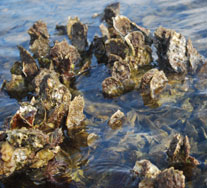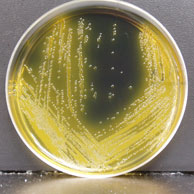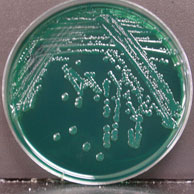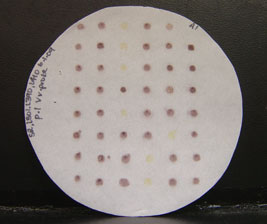Vibrio Studies
Vibrio Studies
The SSL works with the TX Department of State Health Services to monitor the levels of two species of Vibrio bacteria in Galveston Bay oysters. In addition, the SSL works with oyster harvesters along the Gulf Coast to determine the effectiveness of post-harvest processes to reduce the levels of bacteria in their product.
Since 1989, the SSL has monitored the levels of Vibrio vulnificus and Vibrio parahaemolyticus in Galveston Bay oysters throughout the year. This data is provided to the Texas Department of State Health services, so that they may temporarily restrict oyster harvesting from areas of the Bay that may have high bacterial counts, in order to reduce potential Vibrio infections in oyster consumers.

The Texas Oyster Industry
Galveston Bay supports a large and commercially important fishery for the Eastern Oyster (Crassostrea virginica). The Texas oyster industry has a $50 million impact on the state’s economy, and provides roughly 15% of the nation’s total harvest. Texas produced nearly 6.2 million pounds of oyster meat in 2000, with Galveston Bay accounting for 70% of the total production. Additional information regarding oysters in Texas coastal waters is available from Texas Parks and Wildlife.
Oysters and Public Health

Shellfish-related illnesses pose a serious threat to this vital Texas industry and the state’s coastal economy. The presence of the estuarine bacteria Vibrio vulnificus and Vibrio parahaemolyticus cause the vast majority of reported illnesses. Both of these bacteria occur naturally in coastal areas, and neither are the result of bacteriological or chemical pollution of the waters. Both bacteria are found in higher concentrations along the Texas coast from April through October when the waters are warm. The bacteria become concentrated in the tissues of oysters as the animals filter feed, and can then be passed on to oyster consumers if the shellfish are eaten raw or undercooked.

Vibrio vulnificus (Vv): This bacteria is considered the most lethal of the vibrios, generally affecting only “high-risk” individuals including those with liver disorders (hepatitis, cirrhosis, liver cancer), hemochromatosis, diabetes mellitus, or immunocompromising conditions (HIV/AIDS, cancer). Vv can cause gastroenteritis, wound infections, or septicemia, with a >50% mortality rate from septicemic infections. In the past, the media has mistakenly called Vv a “flesh-eating bacteria” due to the lesions and necrotic tissue created by Vv wound infections. These often necessitate surgical treatment or limb amputation, and can be fatal.

Vibrio parahaemolyticus (Vp): This bacteria is the leading cause of seafood-associated gastroenteritis in the United States. Although these infections are generally not lethal, they can affect anyone in the general consuming public, and can necessitate medical attention if severe enough to cause dehydration. For more information on Vp, please see the Government’s Food Safety Vibrio parahaemolyticus Fact Sheet
Post-Harvest Processes
Over the past decade, a number of post-harvest processes (PHPs) have been developed by oyster harvesters to reduce the levels of pathogenic Vibrios in oysters before they are sold to the public. Some of these processes use rapid chilling and individual quick-freezing of the product, while others use high hydrostatic pressure systems or gamma-irradiation to reduce the bacterial levels. The SSL has been at the service of members of the seafood industry to help evaluate the effectiveness of these processes.

Determining the Vibrio levels
Vibrio enumeration (both Vv and Vp) is determined using both gene probe and quantitative polymerase chain reaction (qPCR) procedures. The gene probe procedure provides us with both an MPN (most probable number – statistically the best estimate of the number of bacteria in a sample) and a direct count of the number of colony forming units per ml of sample (CFU/ml). The qPCR provides the level of bacteria in CFU/ml.





